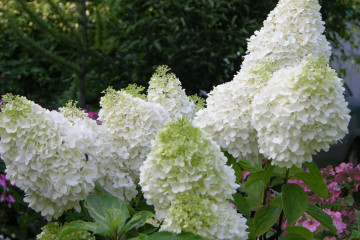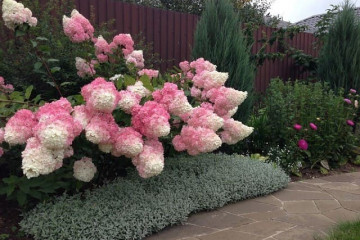Hydrangea Vanilla Fraise: paniculate, garden
Content:
The panicle hydrangea is considered the most beautiful and long-flowering plant. Perennial, due to the absence of difficulties in care, is popular among summer residents and owners of private houses. Even an inexperienced florist can grow in his garden such beauty, pleasing with annual abundant flowering.
Vanilla Freise is one of the brightest representatives of the panicle hydrangea. A chic perennial can be formed not only in the form of a bush, but also in the form of a tree.
Botanical description
We bred Vanille Fraise paniculate standard hydrangea in a French nursery. Painstaking work on this type of perennial began back in 1989. The breeders set themselves the task of developing a variety that will be able to change the color of the petals from white to pink in a short period of time. Thanks to the experience of breeders and their painstaking work, the world saw a gorgeous plant with large inflorescences resembling an ice cream cone and a huge number of flowers. The perennial was named in honor of the complex color of the resulting inflorescences (a combination of white and dark pink).
According to the information specified in the characteristics, the panicle hydrangea shrub reaches a height of 180-200 cm. Flexible shoots are painted in a dark burgundy color. The green foliage densely dotting the branches resembles an oval shape.
The flowering period, which began in early summer, lasts until October. Inflorescences, the length of which is in the range of 30-35 cm, are naturally endowed with a pyramid shape. White petals gradually turn pink, and at the beginning of autumn they acquire a burgundy-red hue. Flowering pleases the grower in the year of planting. The perennial is distinguished by its unpretentiousness and is able to withstand frosts down to -34 ° C.
Transplant after purchase in the open ground of Vanilla Frey
In order for the flowering of a perennial to be colorful and abundant, you should properly care for the shrub. Planting of bushes should be carried out in the spring or autumn. In the case when the seedling was purchased in a tub or pot, it will take root well in the summer.
Lighting and location selection
Hortense Vanilla Fries needs good lighting. Compliance with this condition allows you to get large buds and not lose the saturation of the inflorescence shade. The light should be diffused, since exposure to the foliage of open sunlight provokes burns. The foliage will begin to turn yellow and dry. It is best to opt for a slightly shaded area.
Soil for growing perennial Vanilla Freise
A perennial culture prefers a slightly acidic, moist soil rich in organic matter. The use of limestone soil is unacceptable.
Experienced flower growers recommend independently preparing a substrate for planting, which will include:
- peat;
- sand;
- humus;
- leafy land.
Do not forget about soil mulching.
Landing in open ground
Hydrangea Vanilla Fries should not be planted under trees as they absorb moisture a lot. It is best to plant the shrub in an open area that is protected from direct sunlight. If you ignore this recommendation, the plant will slow down its growth, and the inflorescences will be too small in size.
Landing order:
- The planting hole in the selected location is filled with fertile soil. If desired, you can add fallen needles and a small part of humus to the ground. It is better to refuse the introduction of ash, since the culture does not really like it.
- The root is buried in the hole so that the root collar is located at ground level. The root system must be evenly distributed, and the root processes must be carefully spread out.
- The hole is covered with a layer of soil.
- The soil is abundantly watered and mulched using a layer of peat, sawdust or pine needles. It should be borne in mind that at least 10 liters of water must be poured under each shrub.
The landing recess breaks out in a square shape. If the soil is too wet, a drainage layer of gravel and broken bricks should be placed on the bottom. To speed up the process of adaptation of the seedling, it is worth adding a small amount of a growth stimulant to the hole.
Colloidal sulfur should be used to obtain the required percentage of soil oxidation. In no case should the root collar be allowed to drop. Along the perimeter of the root system, the soil should fit snugly to the perennial, preventing the appearance of voids.
In cases where Vanilla Freise bushes are already growing on the site, you should not spend money on buying new ones. You can propagate a hydrangea by tilting a weighty mother bush and fixing the selected branch on the ground. By spring, the branch will take root, and the grower will have a new perennial seedling.
Hydrangea planted in tubs or pots looks quite impressive. To speed up the growth of Vanilla Freise, it is worth adding a small amount of sand and agroperlite to the soil.
Reproduction Vanilla Fraze
Hydrangea Vanilla Fraze can be propagated in several ways:
- cuttings;
- layering or dividing the mother bushes.
Cutting cuttings, consisting of 4-6 nodes, should take place on the 20th of June. The cut branches are planted in an acidified substrate, which consists of peat and a small amount of sand.
The container with the seedling is placed in a shaded place and covered with polyethylene material. The created mini-greenhouse makes it possible to accelerate the growth of the root system of seedlings. As a rule, cuttings complete the rooting process on day 30. It is at this moment that the film material can be removed. A young plant can be planted in open ground or in a tub.
Reproduction by dividing mother bushes
Step-by-step process of reproduction by layering:
- Choose the strongest lower stem of the bush.
- We bend it to the ground.
- We dig in to a depth of 13-14 cm.
- We fix the layering in the soil with any devices (it is best to use an ordinary hairpin).
- We moisten the soil regularly.
Propagation by cuttings
By dividing the bush, summer residents often propagate perennials. As a rule, this procedure is performed at the time of transplanting mature bushes to new places. For cuttings, shrubs are suitable, the age of which is within 4-6 years.
In order for the delenki to take root well in a new place and firmly endure the winter frosts, it is better to postpone breeding for the spring months.
The shrub is very neatly dug up. The root system must not be damaged under any circumstances! The division is carried out with an ordinary shovel or shears. Each division must contain at least 3 buds.
Caring for Vanilla Fraze
Regularly caring for Vanilla Fries, you can contribute to the formation of lush inflorescences. This perennial variety needs timely fertilization and soil moistening. By trimming the shoots, you can form the desired shape of the plant.
To protect the bushes from diseases, you can use special drugs or folk remedies.
Soil moistening
Vanilla Frazi, a panicle hydrangea variety, loves moisture. The soil under the bush must be moistened every 5-7 days. In no case should the soil dry out and a crust appear on the surface of the earth.
In especially dry periods, the shrub is watered every other day. The roots are located near the surface of the soil, so it is important to pay attention to them. During watering, the root system must not be exposed. After 10 liters of water has been poured under the hydrangea, it is necessary to start hilling the hydrangea of the panicle Vanilla Freise. To moisten the soil less often, you can use mulching the earth with peat or humus.
Top dressing
In order for lush inflorescences to form on hydrangeas of the Vanilla variety, it is necessary to ensure a systematic supply of nutrients to the soil. It is best to use an organic or mineral complex for this purpose. Experienced growers recommend alternating both types of feeding.
The panicled perennial is especially in need of feeding:
- in the spring at the time of swelling of the kidneys;
- during the period when the first buds appear;
- at the time of mass flowering;
- in the autumn months when the bushes are being prepared for winter.
For the first feeding, it is best to use an organic fertilizer, which is based on mullein. Organic matter combines with water (1:15). The solution is thoroughly mixed and poured under the plant bush.
In summer, the perennial is fertilized with mineral complexes. You can prepare top dressing yourself. To do this, you need to use:
- superphosphate;
- potassium salt;
- ammonium nitrate.
The listed substances, taken in equal proportions, dissolve in water.
In the autumn, a mixture of superphosphate and potassium sulfate must be added to the soil. In order not to provoke an increase in the growth of shoots before winter, it is better to abandon the use of nitrogenous dressings in the fall.
Pruning
By pruning, the shrub can be shaped to the desired shape. Pruning should be done in the spring months prior to sap flow. Dried and broken branches must be removed. Shoots can be shortened to 7-8 buds.
Pruning is unacceptable during the summer months. At this time, it is better to start removing dry inflorescences in order to speed up the process of new buds emergence.
Protection against diseases and pests
Hydrangea paniculata Vanilla Freise is susceptible to fungal diseases, which usually affect shoots and foliage. In order to cope with ailments, experts recommend using fungicides, such as Fundazol, Topaz and Fitosporin. At the end of October, for the purpose of prevention, spraying of the bushes can be carried out.
Deficiency of nutrients provokes the occurrence of chlorosis in the Vanilla Freise variety. At the same time, the foliage begins to turn yellow and curl. To cope with the disease, you should apply a complex fertilizer, which includes iron.
In order to cope with the invasion of snails, aphids and spider mites, it is necessary to spray the plant with an effective insecticide like Tanrek and Akarin. You can also use onion peel infusion. A folk remedy is used to treat bushes.
Shelter for the winter
The panicle hydrangea (vanille fraise in Latin) is able to withstand severe winter frosts. Therefore, when breeding perennials in the southern region, you can not cover the bushes for the winter. To protect the flowers from freezing, you should use mulching using peat or humus. The recommended mulch thickness is 25-30 cm.
Panicle hydrangea Vanilla Frize is often used in landscape design. A gorgeous plant, pleasing with abundant flowering, is able to add zest and decorate any site. The tree flower is often used as the main background for undersized flowers. Also, plants are planted near garden arches made of roses.





















